Last week we discussed the anatomy of the knee and what can cause knee pain. Now we’ll delve into how to prevent or alleviate knee pain.
Exercises/stretches
Fortunately there is plenty you can do to prevent knee pain from ever developing. Adding these simple exercises to your routine will greatly improve your knee stability.
Standing abduction (hip-lift)
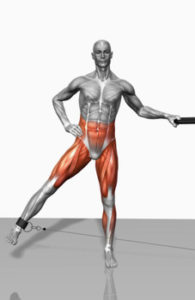
-
- Standing up tall holding onto a sturdy object like a chair or resting your hands on a wall. Raise one leg up and lift it out, laterally away from your body. Pause, and then return to the starting position. Perform 10 to 15 reps per side.
Steps-ups

Step Ups - Place your entire right foot onto the bench or chair. Press through your right heel as you step onto the bench, bringing your left foot to meet your left so you are standing on the bench. Return to the starting position by stepping down with the right foot, then the left so both feet are on the floor. Perform 10 to 15 reps per side.
Glute Bridge with march
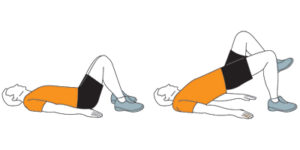
Glute bridge with march
- Standing up tall holding onto a sturdy object like a chair or resting your hands on a wall. Raise one leg up and lift it out, laterally away from your body. Pause, and then return to the starting position. Perform 10 to 15 reps per side.
-
- Lie on your back with both knees bent at about a 90-degree angle with your feet on the floor. Tighten your buttocks as you lift your bottom off the floor as high as you can without arching your back; shoulders, hips and knees should align. Hold this position as you extend one leg up while keeping knees aligned; hold 3 to 5 seconds and lower. Repeat on the opposite side. Perform 10 to 25 reps per side.
Hamstring knee-ins/curls
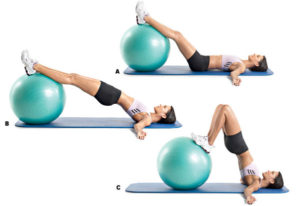
Hamstring knee-ins/curls
- Lie on your back with both knees bent at about a 90-degree angle with your feet on the floor. Tighten your buttocks as you lift your bottom off the floor as high as you can without arching your back; shoulders, hips and knees should align. Hold this position as you extend one leg up while keeping knees aligned; hold 3 to 5 seconds and lower. Repeat on the opposite side. Perform 10 to 25 reps per side.
-
- Begin on the floor laying on your back with your feet on top of the ball. Position the ball so that when your legs are extended your ankles are on top of the ball. This will be your starting position. Raise your hips off of the ground, keeping your weight on the shoulder blades and your feet. Flex the knees, pulling the ball as close to you as you can, contracting the hamstrings. After a brief pause, return to the starting position.
Calf stretch (Soleus & Gastroc)
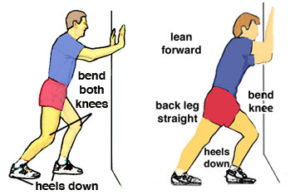
Calf stretch
- Begin on the floor laying on your back with your feet on top of the ball. Position the ball so that when your legs are extended your ankles are on top of the ball. This will be your starting position. Raise your hips off of the ground, keeping your weight on the shoulder blades and your feet. Flex the knees, pulling the ball as close to you as you can, contracting the hamstrings. After a brief pause, return to the starting position.
-
- Stand facing a wall from several feet away. Stagger your stance, placing one foot forward. Lean forward and rest your hands on the wall, keeping your heel, hip and head in a straight line. Attempt to keep your heel on the ground. Hold for 10-20 seconds and then switch sides.
Proper footwear
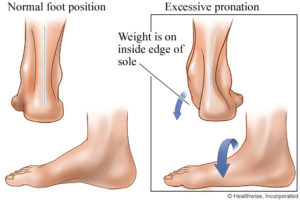 If the source of your knee pain is a problem at your foot or ankle, proper footwear is often an easy solution. Supportive and comfortable orthotics help take pressure off the knee joint by promoting proper leg alignment and balance.
If the source of your knee pain is a problem at your foot or ankle, proper footwear is often an easy solution. Supportive and comfortable orthotics help take pressure off the knee joint by promoting proper leg alignment and balance.
For people with flat feet, orthotics provide arch support to keep the foot aligned and to help control the foot from rolling inward (over-pronation). For people with medium arches, orthotics absorb shock and prevent pain. And for those with high arch feet, orthotics provide a wonderful cushion.
While strength training and stretching can help build up the muscles around the knees to minimize knee injury, a good pair of orthotics or sneakers can make a big difference from the ground up.
There are things all athletes and fitness devotees can do to prevent the prospect of knee problems from happening. In general, that comes from listening to your body and not doing too much at any given time, while also knowing which muscles to strengthen so that your knees and legs are kept in working order. When in doubt, seek a medical professional to properly diagnose your problem and set you on the path to success.
